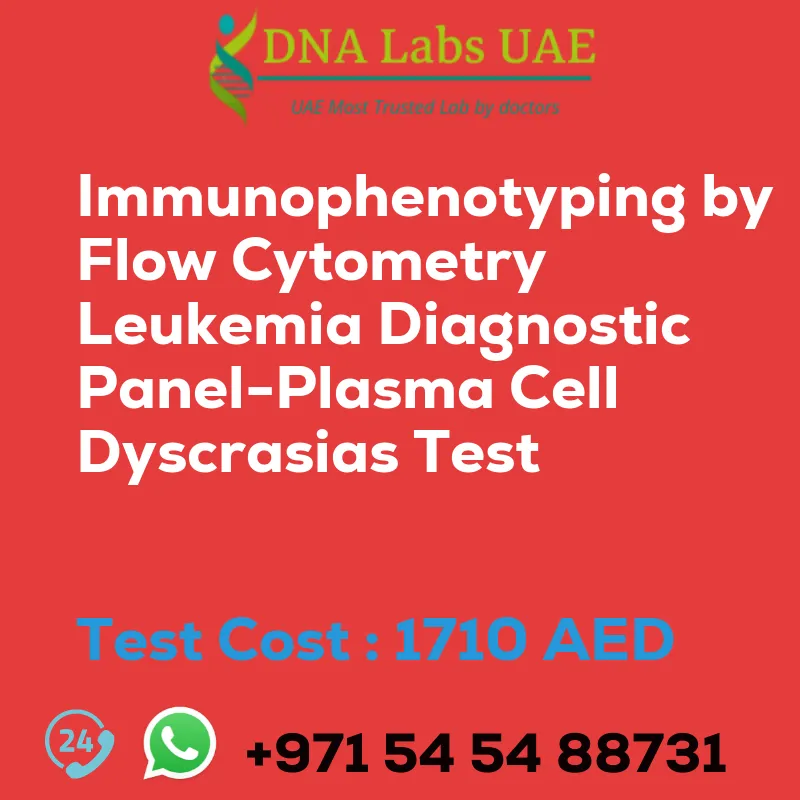IMMUNOPHENOTYPING BY FLOW CYTOMETRY LEUKEMIA DIAGNOSTIC PANEL-PLASMA CELL DYSCRASIAS Test
Test Cost: AED 1710.0
Test Name: IMMUNOPHENOTYPING BY FLOW CYTOMETRY LEUKEMIA DIAGNOSTIC PANEL-PLASMA CELL DYSCRASIAS Test
Test Components: Price: AED 1710.0
Sample Condition: 3 mL (2 mL min.) whole blood each in 1 Lavender Top (EDTA) tube AND 1 Green Top (Sodium Heparin) tube OR 2 mL (1 mL min.) Bone Marrow in 1 Green Top (Sodium heparin) tube AND Aspirate Smear. Ship immediately at 18-22°C. DO NOT REFRIGERATE OR FREEZE. Clinical history is mandatory.
Report Delivery: Sample Daily by 9 am; Report Same day
Method: Flow Cytometry
Test Type: Leukemias
Doctor: Oncologist, Hematologist
Test Department: FLOW CYTOMETRY
Pre Test Information: Clinical history is mandatory.
Test Details
Immunophenotyping by flow cytometry is a laboratory technique used to analyze the surface markers and characteristics of cells. It is commonly used in the diagnosis and monitoring of various diseases, including leukemia and plasma cell dyscrasias.
The leukemia diagnostic panel-plasma cell dyscrasias test specifically focuses on identifying and characterizing abnormal cells associated with leukemia and plasma cell dyscrasias. It involves staining the cells with fluorescently-labeled antibodies that target specific cell surface markers. The labeled cells are then passed through a flow cytometer, which detects and quantifies the fluorescence emitted by each cell.
By analyzing the fluorescence patterns, the flow cytometer can identify and classify different cell types present in a sample. In the case of leukemia, it can help determine the type of leukemia (e.g., acute lymphoblastic leukemia, chronic lymphocytic leukemia) and assess the extent of disease progression. For plasma cell dyscrasias, it can aid in the diagnosis and monitoring of conditions such as multiple myeloma.
Overall, immunophenotyping by flow cytometry is a valuable tool in the diagnosis and management of leukemia and plasma cell dyscrasias, providing important information about the composition and characteristics of abnormal cells in these conditions.
| Test Name | IMMUNOPHENOTYPING BY FLOW CYTOMETRY LEUKEMIA DIAGNOSTIC PANEL-PLASMA CELL DYSCRASIAS Test |
|---|---|
| Components | |
| Price | 1710.0 AED |
| Sample Condition | 3 mL (2 mL min.) whole blood each in 1 Lavender Top (EDTA) tube AND 1 Green Top (Sodium Heparin) tube OR 2 mL (1 mL min.) Bone Marrow in 1 Green Top (Sodium heparin) tube AND Aspirate Smear. Ship immediately at 18\u0192??22?\u00f8C. DO NOT REFRIGERATE OR FREEZE. Clinical history is mandatory. |
| Report Delivery | Sample Daily by 9 am; Report Same day |
| Method | Flow Cytometry |
| Test type | Leukemias |
| Doctor | Oncologist, Hematologist |
| Test Department: | FLOW CYTOMETRY |
| Pre Test Information | Clinical history is mandatory. |
| Test Details |
Immunophenotyping by flow cytometry is a laboratory technique used to analyze the surface markers and characteristics of cells. It is commonly used in the diagnosis and monitoring of various diseases, including leukemia and plasma cell dyscrasias. The leukemia diagnostic panel-plasma cell dyscrasias test specifically focuses on identifying and characterizing abnormal cells associated with leukemia and plasma cell dyscrasias. It involves staining the cells with fluorescently-labeled antibodies that target specific cell surface markers. The labeled cells are then passed through a flow cytometer, which detects and quantifies the fluorescence emitted by each cell. By analyzing the fluorescence patterns, the flow cytometer can identify and classify different cell types present in a sample. In the case of leukemia, it can help determine the type of leukemia (e.g., acute lymphoblastic leukemia, chronic lymphocytic leukemia) and assess the extent of disease progression. For plasma cell dyscrasias, it can aid in the diagnosis and monitoring of conditions such as multiple myeloma. Overall, immunophenotyping by flow cytometry is a valuable tool in the diagnosis and management of leukemia and plasma cell dyscrasias, providing important information about the composition and characteristics of abnormal cells in these conditions. |








